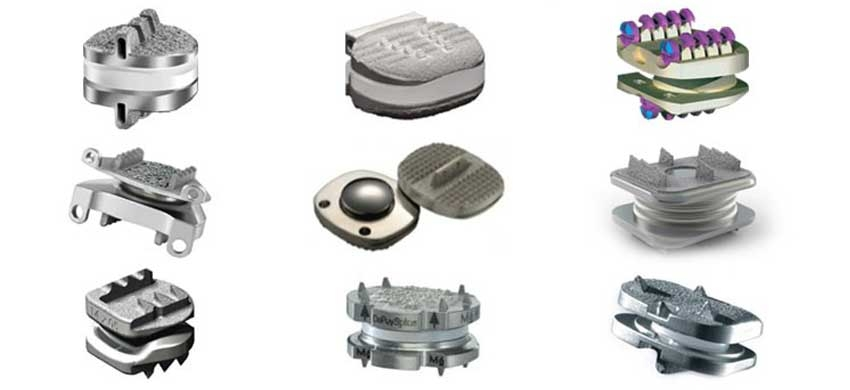
Total Disc Replacement
The natural cervical intervertebral disc is an amazing mechanical structure from an engineering perspective. It has the ability to absorb a large compressive load while still providing an impressive range of motion between the bones in the neck. Duplicating the natural disc’s form and function with a synthetic—or artificial—disc is challenging. However, several artificial cervical discs have been developed and are available as a surgical option for patients with symptomatic cervical disc problems.
What Is an Artificial Cervical Disc?
An artificial cervical disc is a device inserted between two vertebrae in the neck to replace a damaged disc.
The intent of the artificial disc is to preserve motion at the disc space. It is an alternative to the commonly performed anterior cervical discectomy and fusion (ACDF), a surgical procedure that is designed to address the pathology by eliminating motion at the diseased disc level.
Artificial disc replacement (ADR) surgery—also known as a total disc arthroplasty or total disc replacement (TDR)—is performed for a patient with a cervical disc herniation that is causing significant neck pain and/or arm pain that has not responded to nonsurgical treatment options and is significantly affecting the individual’s quality of life and ability to function.
The theoretical advantages of the artificial cervical disc compared with a fusion include:
- Maintaining normal neck motion
- Reducing degeneration of adjacent segments of the cervical spine
- Eliminating potential complications and issues associated with the need for a bone graft and the hardware used in ACDF surgery
- Allowing early postoperative neck motion
As with all operations, there are potential risks and complications associated with cervical artificial disc replacement.

Indications for a Cervical Disc replacement
The indications for a cervical disc replacement are similar to those for a cervical discectomy and fusion (ACDF). A patient must have a symptomatic cervical disc, which may be causing arm pain, arm weakness or numbness, and/or some degree of neck pain. These symptoms may be due to a herniated disc and/or osteophytes (bone spurs) compressing adjacent nerves or the spinal cord. This condition most commonly occurs at cervical spine levels C4-C5, C5-C6, or C6-C7.
Prior to being considered for a cervical disc replacement, the candidate must usually meet defined criteria, such as:
- Significant neck pain and/or pain, and possibly neurological symptoms, that radiates into the arm(s)
- At least 4 to 6 weeks of nonsurgical treatment, usually consisting of at least anti-inflammatory medications, physiotherapy, or epidural injections
- No prior neck surgery (typically)
- Suitable general health for safe anesthesia
- Only one, or possibly two, levels of the neck affected
- Absence of all of the following:
- Active infection
- Allergy to the implant material
- Facet joint arthritis in the cervical spine
- Clinical or X-ray evidence of instability
- Osteoporosis
Disc replacement vs anterior cervical discectomy and fusion
There are a number of important factors in considering cervical disc replacement versus a traditional anterior cervical discectomy and fusion (ACDF) surgery. A patient may be most suitable for either cervical disc replacement or ACDF as a result of his or her symptoms or amount of disc degeneration. The options for each individual patient are best discussed with your surgeon.
It is important to remember that a disc replacement is a motion-preservation procedure and not a motion-creation procedure. This means that a discectomy does not increase range of motion. Following discectomy, even though an artificial disc has been inserted, an ankylosed (fused) or severely spondylotic (stiff) disc that did not move before disc replacement is not likely to move after disc replacement. As with all newer technologies, one important consideration with artificial cervical disc technology is that long-term studies and follow-up are needed to fully understand the potential risks and benefits of cervical disc replacement.
Surgical Procedure for Cervical Disc Replacement
The standard surgical procedure for a cervical disc replacement requires an anterior approach (from the front) to the cervical spine. This surgical approach is the same as that used for an anterior cervical discectomy and fusion (ACDF) operation.
The cervical ADR surgery will typically include the following:
- An incision is made in the front of the neck, then the neck muscles, trachea, and oesophagus are moved aside in order to access the front of the cervical vertebrae and discs.
- The affected disc is completely removed, as are any disc fragments or osteophytes (bone spurs) that are pressing on the nerve or spinal cord.
- The disc space is distracted to its previous, normal disc height to help decompress the surrounding nerves. Restoring the original disc height is important; when a disc becomes worn out, it will usually shrink in height, which can contribute to nerve pinching in the neck.
- Using X-rays or fluoroscopy as guidance, the artificial disc device is implanted into the prepared disc space.
Postoperatively, the patient can go home within 24 hours with minimal activity limitations.